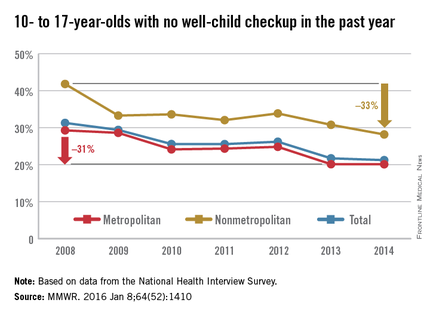The percentage of all children aged 10-17 years who did not receive a well-child checkup is down since 2008, but there is a considerable gap between those living in metropolitan and nonmetropolitan areas, the Centers for Disease Control and Prevention reported.
In 2014, 21% of all 10- to 17-year-olds had not had a well-child checkup in the past 12 months, compared with 31% in 2008, said Lindsey I. Black and Anjel Vahratian, Ph.D., of the CDC’s National Center for Health Statistics in Hyattsville, Md. (MMWR 2016 Jan 8;64[52]:1410).
Those living in nonmetropolitan areas, however, were at a consistent disadvantage over the 6-year period, compared with their metropolitan counterparts. In 2014, 28% of the children had not had a well-child visit in the past 12 months, compared with just over 20% in metro areas, according to data from the National Health Interview Survey.
The nonmetropolitan areas did show a slightly larger relative decrease from 2008 to 2014 than the metropolitan areas – 33% vs. 31% – so the gap has closed slightly over time.
Metropolitan residences are those located within a county or group of contiguous counties containing at least one urbanized area with a population of 50,000 or more, along with surrounding counties that have strong economic ties to the urbanized area. Nonmetropolitan areas do not include a large urbanized area and are generally more rural, the investigators noted.


